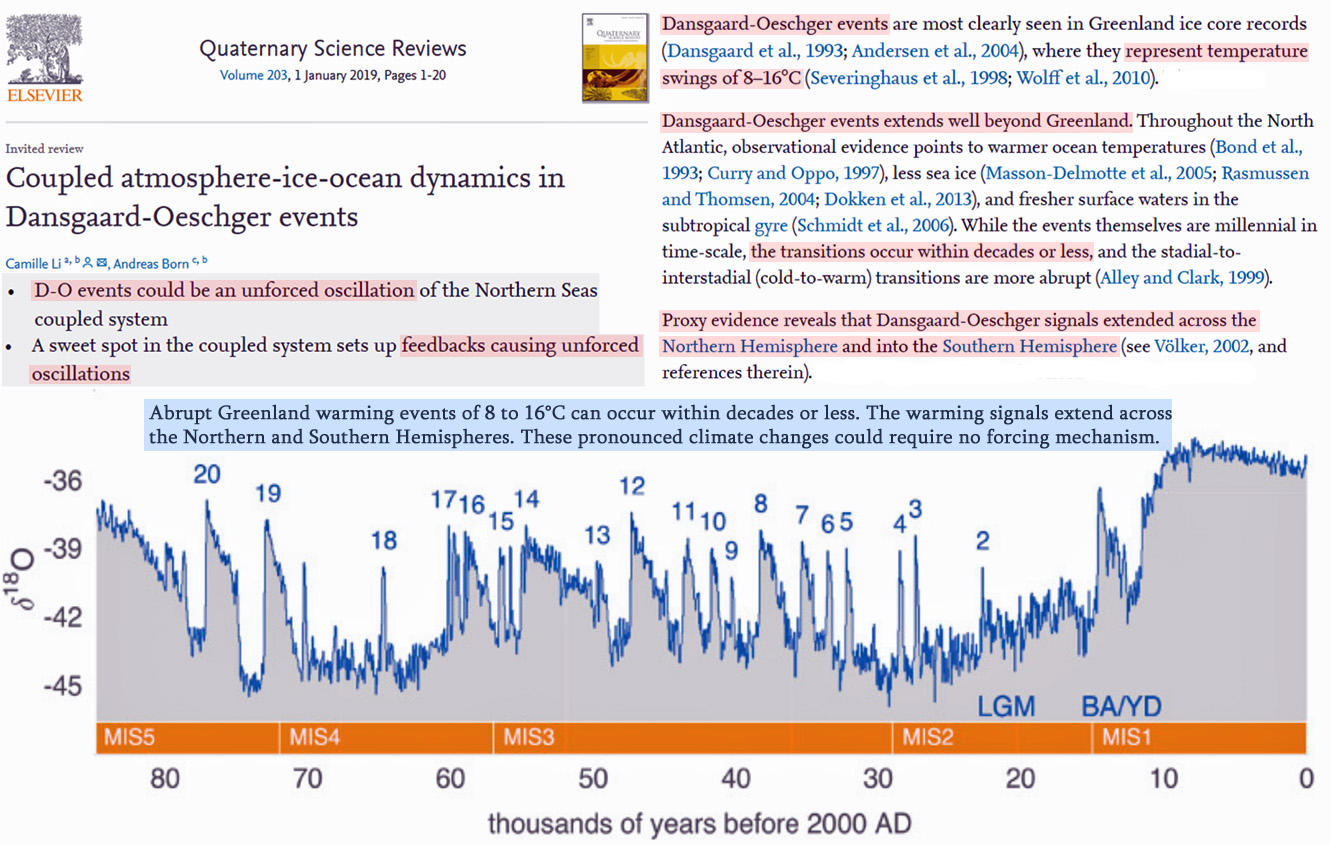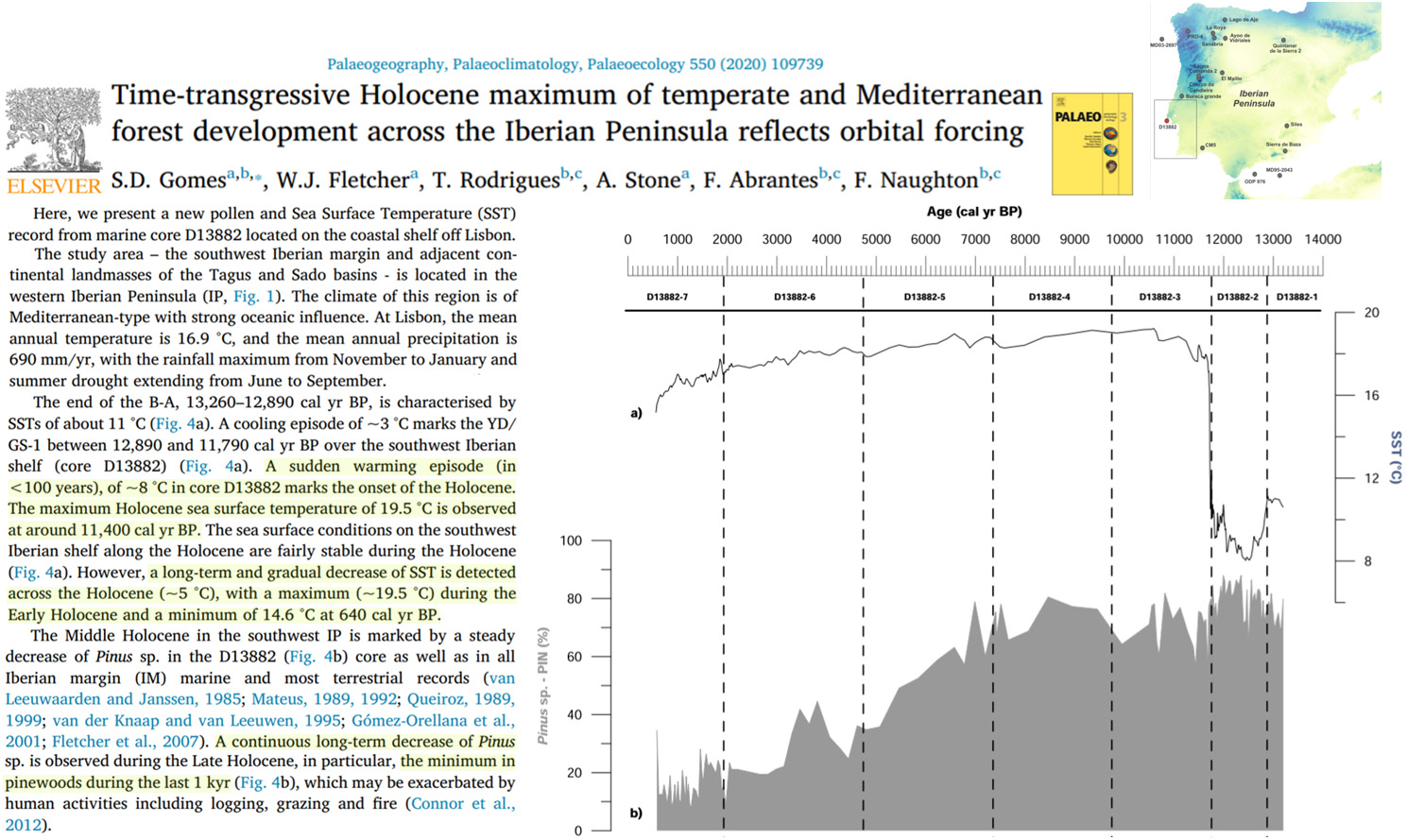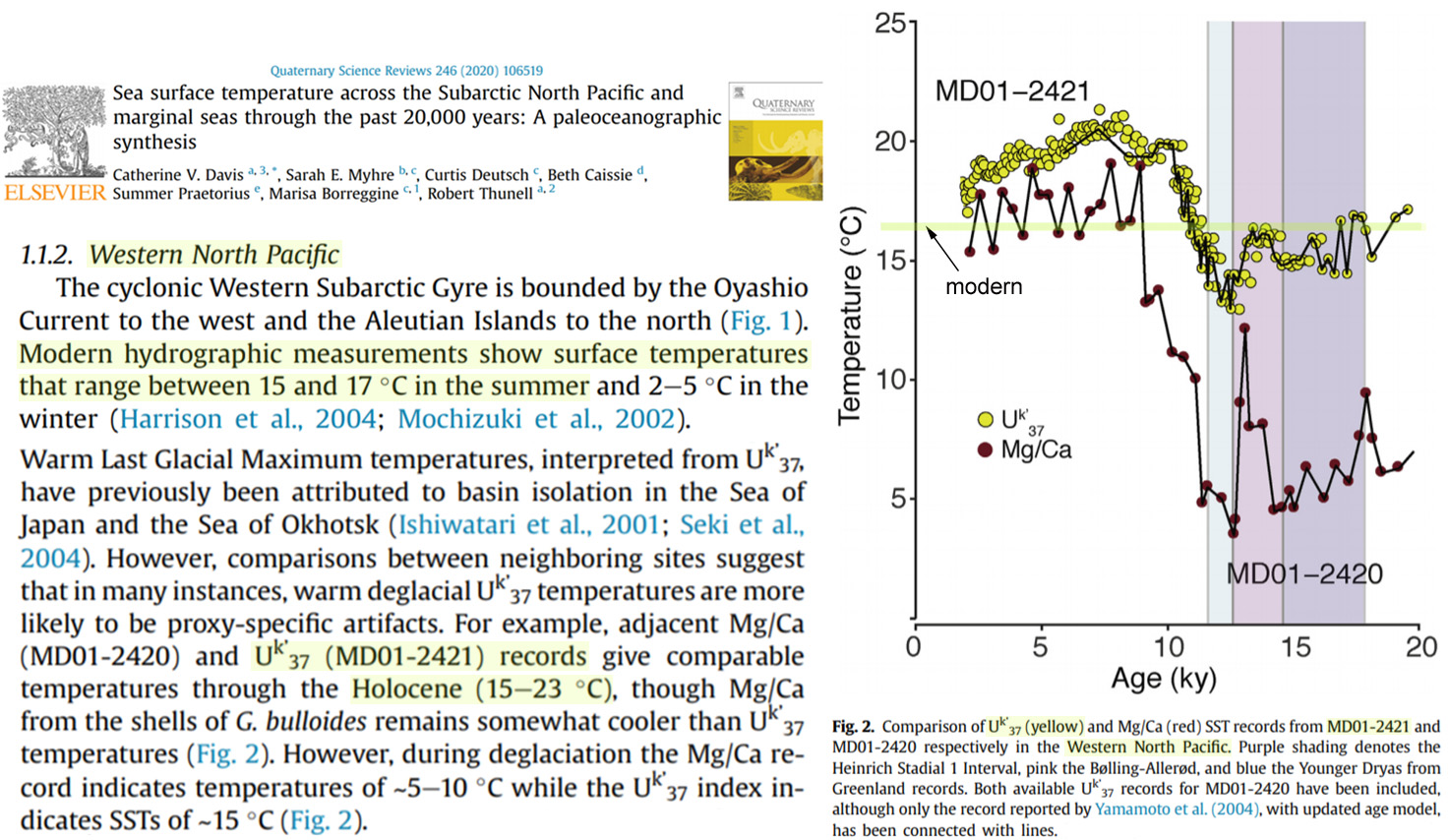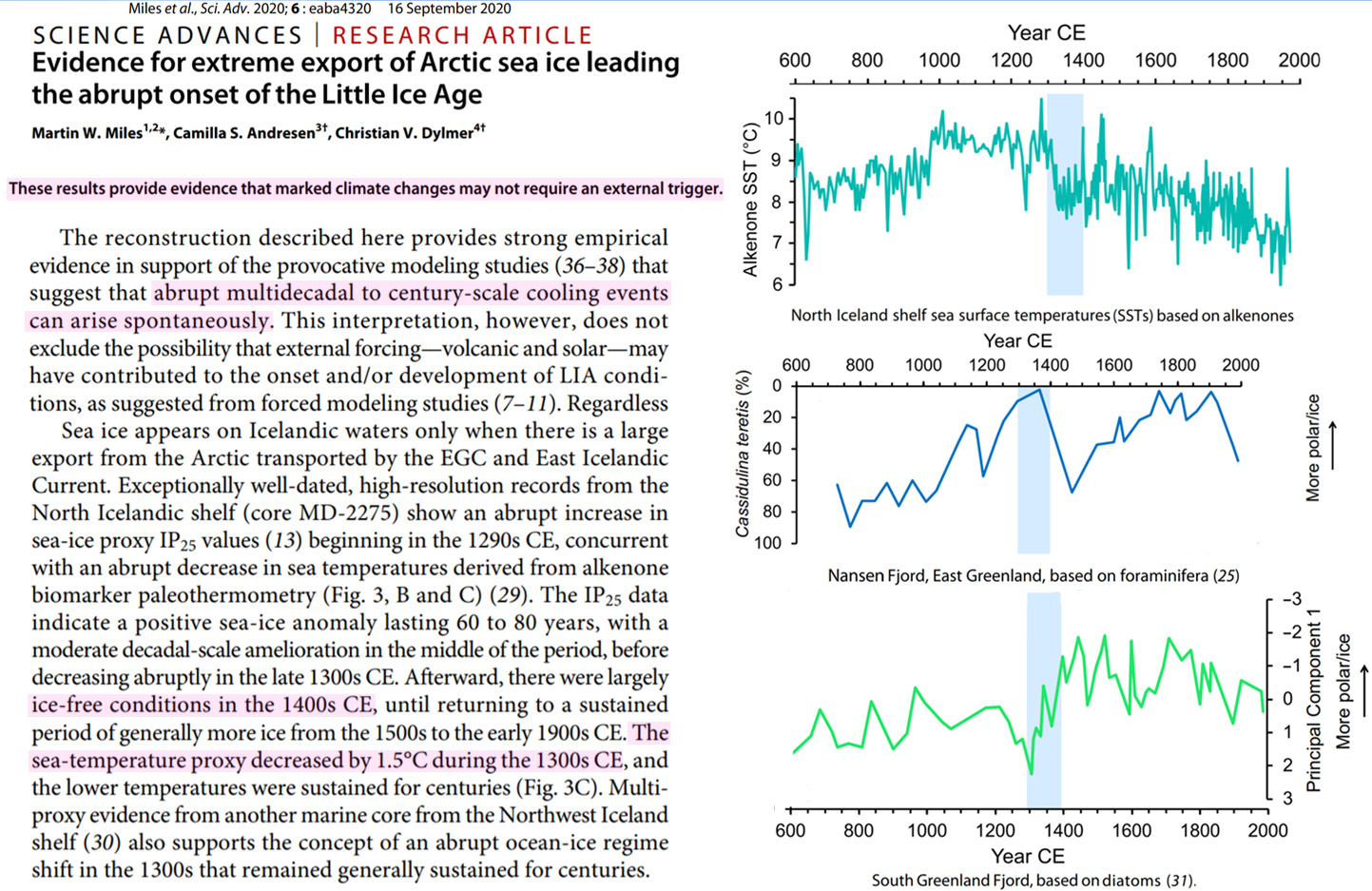Scientists are increasingly finding that abrupt, decadal-scale temperature changes of multiple degrees Celsius can arise unforced and spontaneously.
The surface temperatures for the Greenland ice sheet have been known to warm 8 to 16°C “within decades or less” – yes, fewer than 10 years – due to “unforced oscillations.” In other words, no external forcing mechanism is required for these abrupt warming events (Li and Born, 2019).

Image Source: Li and Born, 2019
Scientists (Gomes et al., 2020) examined the sea surface temperatures (SSTs) off the coasts of Lisbon in a newly published study. In addition to finding the SSTs were 5°C warmer (19.7°C vs. 14.6°C) about 11,000 years ago compared to the last millennium, they record a “sudden warming episode (in <100 years), of ~8 °C” for this region. That’s a warming of nearly 1°C per decade.

Image Source: Gomes et al., 2020
Modern summer sea surface temperatures in the Western North Pacific average 16°C (15-17°C) (Davis et al., 2020). Proxy evidence indicates peak SSTs reached 20-23°C ~8000 to ~6000 yrs ago, and SSTs twice warmed 4-5°C in a century or two during the Early Holocene.

Image Source: Davis et al., 2020
Another new study finds Iceland was ~2°C warmer and the Arctic region had much less sea ice as recently as ~1400 to 1000 years ago (Miles et al., 2020).
What’s most interesting is that in the last 1400 years the Arctic experienced marked climate changes (~1.5°C in decades) that may have occurred “spontaneously,” or without requiring “an external trigger”. In other words, these warming events may arise due to unforced natural variability.
If climate changes of these magnitudes can and do occur without an external forcing mechanism, there is little reason to assume that the much more modest changes in SSTs in the last century fall outside the range of internal variability either.






In view of the ocean’s immense heat capacity, the sun doesn’t look like a probable cause of such abrupt warming.
We know that ocean water penetrates the earth’s crust down to several miles, and it comes out of there heated to extremely high temperatures that reflect the temperature of the magma that came in contact with it.
How much energy does it take to move a tectonic plate from point A to point B, and push it under another plate? How much energy does it take to move all of them from the ocean ridges to the subduction zones?
Mid-ocean ridges and subduction zones stretch across tens of thousands of miles, and they are the first places to look for enough heat to generate such marked changes in ocean water temperature within such a short time.
Plate tectonics and submerged volcanic activity come to mind as a plausible explanation.
“What’s most interesting is that in the last 1400 years the Arctic experienced marked climate changes (~1.5°C in decades)that may have occurred “spontaneously,” or without requiring “an external trigger”.
An interesting idea but I remain skeptical.
Nature has been found to be full of so called ‘spontaneous’ changes that upon further research was found to be caused by natural changes (Or an aggregation of many natural changes, some long term others quite short order.) that caused such events.
Only time and further study will tell.
Overall these studies appear very worthy of the types of sudden change that this planet can undertake without an obvious cause.
Sudden warming and sudden cooling, so far international science opinion has erred on the warming event. What if they are wrong and sudden cooling is about to happen? Are we ready for such a cooling? If not why not?
This graphic https://climate4you.com/images/GISP2%20TemperatureSince10700%20BP%20with%20CO2%20from%20EPICA%20DomeC.gif
shows that for at least the last 4k years this planet has been on a cooling trend.
Graphic caption says “The upper panel shows the air temperature at the summit of the Greenland Ice Sheet, reconstructed by Alley (2000) from GISP2 ice core data. The time scale shows years before modern time. The rapid temperature rise to the left indicate the final part of the even more pronounced temperature increase following the last ice age. The temperature scale at the right hand side of the upper panel suggests a very approximate comparison with the global average temperature (see comment below). The GISP2 record ends around 1854, and the two graphs therefore ends here. There has since been an temperature increase to about the same level as during the Medieval Warm Period and to about 395 ppm for CO2. The small reddish bar in the lower right indicate the extension of the longest global temperature record (since 1850), based on meteorological observations (HadCRUT3). The lower panel shows the past atmospheric CO2 content, as found from the EPICA Dome C Ice Core in the Antarctic (Monnin et al. 2004). The Dome C atmospheric CO2 record ends in the year 1777.”
Hi, TomO.
My take on that is that the energy is already in the system, and that a confluence of factors will result in a “spontaneous” localized (not global) change, which will then dissipate. That requires no additions to the system, so it isn’t “external,” but occurs because the system itself is dynamic and chaotic. Thoughts?
Yonason
I agree with your take that the heat is “already in the system”.
There is a huge temperature gradient from near freezing water at the deepest ocean (average 4km deep) and the surface that can have water temperature of 30 C in the same place.
So a change in the amount of mixing of deep and surface water, at locations of upwelling and downwelling, can change surface temperature greatly in a fully “adiabatic” process meaning no heat enters or leaves the system as a whole.
When you think about it, ocean processes in the short term (decades) have to be nearly adiabatic since the ocean’s heat content and capacity are so unimaginably vast.
So at any time any internal process that changes vertical mixing in the ocean will change surface temperature.
It is a huge error at the heart of climate science that any change in temperature of ocean and atmosphere has to be “forced” from outside. This is false. Climate can change itself.
To understand how you need to understand how the 3D circulating ocean system can operate as a chaotic excitable medium. Intermittent positive feedbacks can lead to rapid changes that appear from the outside as spontaneous.
Such internally generated changes include ENSO excursions, AMOC variations ie the AMO, and the extraordinarily violent DO climate oscillations during the last ice age.
Thanks for this important and enlightening article and paper links.
[…] New Research Shows The Oceans Can ‘Spontaneously’ Warm 8°C In Under 100 Years ‘Wi… […]
There are various hypotheses (inclding a comet strike that started the rapid melting of the Laurentian Ica Sheet in North Americ) to explain the temperture dynamics as the globe warmed at the time of Younger Dryas which are not seen as “spontaneous or unforced”… see:
https://medium.com/@humanoriginproject/evidence-of-global-warming-the-end-of-the-last-ice-age-a54f5e40d9b3
[…] https://notrickszone.com/2020/12/17/new-research-shows-the-oceans-can-spontaneously-warm-8c-in-under… […]